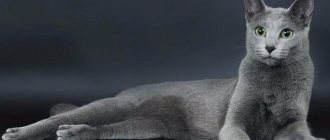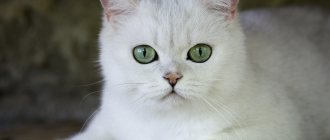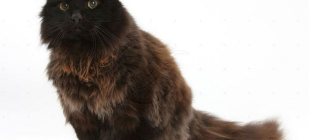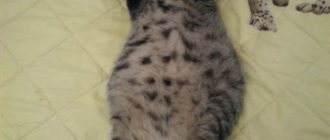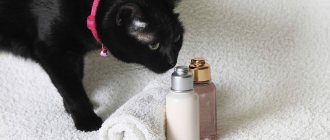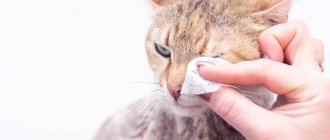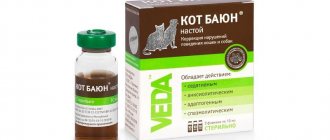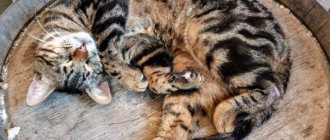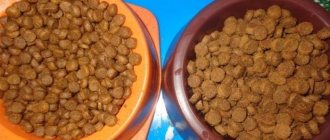Among hundreds of varieties of domestic cats, cat breeds with green eyes are especially popular.
Independent and affectionate, smooth-haired and fluffy, large and miniature breeds are being improved, delighting breeders and bringing happiness to the lucky owners of purrs. In February 2016, the international club of cat lovers “Cat Fancier's Association” took into account 42 new breeds that were bred in different countries. How to find green eyes among all the diversity of the cat kingdom?
© shutterstock
The most beautiful gray and smoky rocks
The gray or smoky color of a cat's coat is a symbol of thoroughbred and nobility.
Under the sun, cats' fur coats can be blue or charcoal gray, and at dusk they can have a silver and platinum color.
British shorthair cat
The appearance of the British shorthair from Foggy Albion amazes with its beauty at first sight. The average weight of cats is from 4 to 6 kg. Sometimes there are representatives of the British up to 8 kg in weight. A large physique does not prevent cats from being dexterous and graceful.
British shorthair cat
The pet's fur is soft to the touch and appearance, similar to plush fabric. The deep gray color was passed on to the British cats from their ancestor - the Persian. Eye color varies from yellow to red-orange.
The temperament of British cats is Nordic. They are calm, balanced and patient.
Otherwise, the British are excellent nannies, steadfastly enduring the games of small children. Representatives of this breed are attached to their owners, but do not show excessive intrusiveness.
Most often, handsome British Shorthairs are bred for home keeping. Pets easily get along with other household members and brothers.
Persian
Representatives of Persian cats are radically different from their gray counterparts. The appearance of pets cannot help but make you fall in love with yourself. The majority of the bodies are medium to large. The weight of cats reaches 8 kg, but on average 5-6. Kitties are a little smaller – 3-4 kg. The structure of the head and the shape of the muzzle divides Persians into 2 types. Classic - the nose is shortened, but wide and has an upturned position. Extreme - the muzzle is flat, slightly depressed, and the nose is snub-nosed and small.
Persian
The coat can be short or long. It is soft to the touch and shiny in appearance. The eyes are round and the color varies in a wide range of blue and orange tones.
The character of Persian cats is willful, but without malice. They are adapted only for living at home; they cannot stay in the wild for long. They get along well with children and are moderately playful. They get along well with other animals only if they are of the same age. They quickly become attached to the owner, choosing only one family member. They need attention, affection and care. By temperament they are not aggressive, not loud.
Persians are bred exclusively for keeping in an apartment or house. Despite their independence in behavior, they need comfort and coziness.
Russian Blue with green eyes
Representatives of the Russian Blue are highly valued both in Russia and abroad. The appearance of the pet is beautiful and graceful. The build is light, weight does not exceed 4-7 kg. The wool has a deep gray color with a blue tint. The length of the pile is small, but it covers the body with a dense layer and feels soft and elastic to the touch.
They get along well with other family members and children. Russian Blues are wary of strangers and do not like large crowds of people. Sometimes they can be stubborn.
Russian blue cat
The Russian Blue's eye color is predominantly green. It may change over time and the shade becomes close to gray.
Russian Blue cats are bred for indoor use, despite the fact that they enjoy spending time outside.
The cat breed is widespread on all continents.
Scottish fold
The Scottish Fold breed translated into Russian means Scottish Fold. This moment is their distinguishing feature of appearance. The physique of the pets is moderately muscular and strong. Weight varies from 4 to 6 kg. The coat is predominantly short and feels soft and plush to the touch.
At the same time, they do not have the habit of being too annoying with their attention. They are neat and clean. They easily find a common language with children and show patience with their games. They get along quickly and efficiently with dogs and other domestic animals.
Chartreuse
According to one legend, the first representatives of this small breed of gray cats were brought to France during the Crusades. According to another version, they appeared as a result of targeted selection. If you believe this theory, then their ancestors are Pallas' cats and Egyptian cats. Be that as it may, Chartreuse received official recognition only in 1939.
Representatives of this breed of gray cats have a strong, dry body with a short neck and well-developed muscles. On the round, wide head of the Chartreuse are high-set ears and beautiful golden eyes. As for color, it varies from ashy to blue-gray.
These cats have a calm, silent character. They are very patient with children and show intelligent restraint towards strangers. Chartreux quickly adapts to any conditions and remains calmly alone. They are quite playful and retain this valuable quality until old age.
Description of the gray cat breed
Gray color is found among representatives of a wide variety of cat breeds. The gray color can be smooth smoky or tortoiseshell, tiger or leopard. The gray tone varies from light silver to the so-called black tabby.
One of the most popular cat varieties in our country is the British Shorthair.
TABLE OF CONTENTS:
Signs of a purebred British:
- Round massive head;
- Wide neck;
- Small ears, slightly rounded;
- Tight build;
- Short strong limbs.
This is a small gray cat with yellow eyes. The breed was bred back in the 19th century and over the years of its existence has gained wide popularity.
Korat
This is one of the oldest breeds of gray cats. The name "korat" can be seen on the pages of Thai books published in the years 1365-1770. The ancestors of modern representatives of this breed were wild silver-blue cats that lived high in the mountains. In 1959, the first Korats came to America and aroused considerable interest among professional breeders. From that moment on, they quickly spread throughout the world and gained popularity among cat lovers.
Korats are not very large animals with a strong muscular body. The weight of an adult varies from 2.5 to 5 kilograms. Moreover, females are noticeably smaller than males. They have a slightly elongated body with a wide chest and a straight back. Under the cat's body are strong, sinewy limbs. The Korats' front legs are slightly shorter than their hind legs. The broad, heart-shaped head has round green eyes and neat, movable ears. Korats are a fairly popular breed of gray cat (photos of these animals can be seen in today’s publication). They are very smart, sociable and curious.
Character
Many breeders claim that the character of the animal may depend on the color of the skin. So, some believe that red representatives of the cat family are the smartest, and black ones are soft and docile.
Regarding gray individuals, there is a version that they are calm individuals with a phlegmatic character. The peculiarity of gray cats is their affection and devotion to their owner. Kittens with gray eyes are considered the most affectionate.
But in many ways, the pet’s temperament depends on the breed. For example, while a Siberian cat will have time to scratch the curtains and jump out of the window (they are convenient to keep in country houses), a lazy Persia will calmly lie on the carpet.
Nibelung
Representatives of this breed of gray cats are considered descendants of the famous Russian Blue. Nibelungs are not very large animals. The average weight of an adult does not exceed five kilograms. They have a slightly elongated body with well-developed muscles and a long neck. On a small wedge-shaped head with a high forehead and a specific nose line, there are rectangular ears and expressive green eyes. The body of the Nibelung is covered with fine silky hair that is not prone to matting. The fur of these animals is always blue with a silver tint.
Representatives of this breed seem to be created for life in a confined space. They adapt well to being kept in small apartments, but if they are given complete freedom and a large fenced yard, they will behave like real hunters. Nibelungs are distinguished by their intelligent, peaceful disposition. These cats are not prone to competition with other animals.
How much does a gray cat cost?
The price of a cat largely depends on the breed, its origin, purebred and other parameters. Below is a table that describes how much kittens cost for those breeds in which silver colors are more common than others.
The table shows average prices:
Attention! Purebred cats are rare. If you want to purchase a copy of “blue” blood of a specific color or quality, you will have to familiarize yourself with the breeding plan in nurseries and submit a request in advance to purchase a kitten from the future litter.
Maine Coon
The Gulliver cat cannot be confused with any other breed. A long body, high strong legs, powerful paws, a luxurious tail, lynx tufts on the tips of the ears and, of course, an indescribable expression on the face, serious and good-natured at the same time. The Maine Coon's coat is not very thick, but it is quite long. Breed standards allow many colors. And there is no doubt that a blue Maine Coon (like any other) looks very stylish! These are smart, playful, sociable, but unobtrusive cats.
The Maine Coon is one of the most famous, recognizable and popular breeds bred by American breeders. However, selection, in the modern sense, began only in the middle of the last century. Meanwhile, evidence of the existence of these cats dates back to the middle of the 20th century: the first known Maine Coon made a splash at a country fair, striking the public with its impressive size and shaggy appearance.
Origin story
The smoky color of a cat's fur is possible only due to the manifestation of the Agouti gene. Geneticists call all gray cats this word. This gene can have dominant and recessive forms.
When the recessive gene manifests itself, the kitten is born with a solid, even color, and the dominant Agouti alternates dark and light stripes on the hair, resulting in a striped or spotted skin.
Basic information about the history of the origin of gray cats can be found in special books on genetics.
Richness of color
The fur of any British cat is thick, can be long or short, and resembles a teddy bear. This is ensured by the same length of the coat itself, as well as the undercoat. Among all the existing colors of the British, the main types of color are distinguished:
- black;
- blue;
- chocolate;
- lilac;
- red;
- cream;
- white;
- cinnamon;
- faun;
- tortoiseshell;
- color point;
- bicolor;
- tabby;
- silver.
The cinnamon color appeared relatively recently and is considered one of the rarest among this breed. Its second name is ground cinnamon. Due to genetic characteristics, only cats can have this fur color.
Tabbies can be divided into three groups:
- marble;
- brindle or striped;
- spotted.
Tabby cats gained popularity after the release of a Whiskas advertisement featuring the main character, a cute British cat with stripes. Today we will look in more detail at the features of the British tabby cat and try to determine which name is most suitable for a boy and a girl.
The main rule for fluffy cats with stripes is that the lines should be clear, without breaks. The more stripes, the more beautiful the pet. On the forehead there is a pattern resembling the letter “M”. There is a spot on the surface of the ear the size of a fingerprint.
The fur coat of a purebred kitten is gray with many stripes of various shades, up to black. There are closed stripes on the chest, reminiscent of a girl’s necklace.
What to feed?
Cat owners are divided into two camps: some feed their pets exclusively with food, others advocate homemade food.
Both options can provide your pet with absolute health, but only if certain rules are followed:
- Never mix food with regular food. Such a diet can cause serious gastrointestinal diseases;
- Do not change prepared food. Choose one manufacturer once and for all;
- Provide the cat with round-the-clock access to drinking water;
- If the choice falls on ready-made food, then preference should be given to the holistic or premium food category;
- Homemade food does not mean human food. The cat's stomach is not suitable for digesting cereals and soups.
The diet of a predator should include raw meat, without streaks, vitamins (which are sold in pet stores), a small amount of raw vegetables and dairy products.
It is extremely difficult to independently calculate the ratio of all trace elements. Therefore, most breeders, when thinking about what to feed their cat, prefer ready-made food. Reviews show that high-quality food does not harm the cat’s body.
Features of care
Weekly brushing of the coat in animals with short hair and 2-3 times a week in animals with long hair is quite sufficient. During the molting period, perhaps more often. The use of slicker brushes is not recommended; the animal may lose its luxurious undercoat and lose its characteristic appearance. Bathing, like most cats, is allowed, but only if necessary.
Hygiene of the ears is mandatory, which, due to the breed’s shape, can become heavily contaminated with earwax and cause discomfort to the pet. Regular eye hygiene and nail trimming are also necessary.
Health of the Scottish Fold
The gene for lop ears in Scottish Folds is associated with a pathological change in the skeletal system - osteochondrodysplasia, typical manifestations of which are various bone deformations, immobility and pain in the tail. Pathology can manifest itself at any age - in a young animal or an adult.
Osteochondrodysplasia is characterized by the following features:
- lameness;
- stiff gait;
- the animal’s reluctance to jump;
- acute reaction to touching the tail;
- uncharacteristic squatness of the pet.
To prevent this disease, it is recommended to prevent lop-eared pets from mating with lop-eared ones; it is in such cases that mutations of the musculoskeletal system appear. Cardiovascular disease is common in these cats. To prevent them, it is recommended to prevent animals from becoming overweight, to which they are predisposed due to their good appetite.
Quite often there is a problem such as entropion of the eyelids, which is easily solved by surgical intervention. Age-related pathologies include glaucoma and cataracts. Dermatological disorders are manifested by allergies and eczema, as well as all kinds of parasitic problems (demodex, scabies). Ear diseases include infectious otitis media and congenital deafness (complete or partial).
Scottish Straights, unlike Scottish Folds, are more hardy and have virtually no hereditary predisposition to such diseases. To prevent infectious diseases, a mandatory recommendation is to vaccinate pets (rhinotracheitis, panleukopenia, calcivirosis, chlamydia, rabies).
Feeding recommendations
When using natural ingredients in feeding an animal, you should ensure that they are of good quality. The diet must be compiled taking into account the physiological and age-related needs of the pet, with the correct ratio of essential nutrients, minerals, trace elements and vitamins. The diet should include: lean types of meat (chicken, turkey, beef). It is recommended to include in the diet: liver, offal, sea fish, cheese, cottage cheese, raw eggs, cereals and vegetables. It is necessary to exclude from consumption: lamb, pork, legumes, potatoes and onions.
If an animal is fed with prepared food, it must be of appropriate quality. It is recommended to use premium and super-premium food.
Cost of a Scottish Fold kitten
The price of a pet directly depends on its breed characteristics, rarity or color features, and pedigree. On average, this is 5,000-30,000 rubles.
Smoky cat: breed overview
Smoky colored cats are very popular. They are credited with mystical properties and superpowers, but the peculiarity of such cats is still their unusual appearance. The fur has the ability to change tone in different lighting: in the sun it shimmers with bright tones, and in twilight lighting it appears monochromatic. The smoky cat is a symbol of nobility and thoroughbred. These are real beauties who will not leave a single person indifferent. A variety of breeds with a “smoky” color will allow you to make a choice to your liking.
Smoky cat: breed overview
Scottish lop-eared
These animals are very similar to the British. They appeared due to a random mutation. The Scots have a small, powerful body with well-developed muscles and a broad chest. On the rounded head of these animals there are large eyes and ears curved forward and down. Their body is covered with thick, short and very soft hair. As for the color, it can be anything, including blue, red, lilac and chocolate.
Having figured out what breed a gray cat with unusual floppy ears is, you need to mention its character. Scots are very friendly and affectionate creatures that need constant attention. They quickly get used to their owners and do not require special care.
Australian mist
Mist was bred in Australia. Breeders living on the mainland wanted to create their own special breed. The breeding process lasted 11 years, from 1975. In the end, the local specialists managed to achieve their goal, and in 1986 a new unique breed was bred. In the same year it was officially registered. The cat adopted its color from the Burmese breed , ticking (speckles, stripes on the paws and tail, ripples) - from the Abyssinian , spots - from ordinary pets.
Breed Features
The maximum weight of an Australian cat is 8 kg (for males), the minimum is 3-4 kg (for females). The animal's chest is wide and its body is quite muscular. These features distinguish the Australian cat from its fellows.
Table 1. Distinctive features of the Australian myst
Important! The fur coat of the Australian “haze” always has a pattern. It is presented in the form of specks or “marbles”. The pattern is finally formed in cats by the age of 2 years.
Character
The character of Australian mysts is flexible. They very rarely get angry and release their claws. Therefore, they can be easily acquired by families with small children. Such cats are quite patient and quickly find a common language with strangers. It tolerates separation from its owners easily. Mist kittens are hyperactive. But gradually, with age, their ardor fades away. Adults want to spend time with their owner all day long. They are ready to follow him for days, rub against his legs, gently purring and proving their devotion.
Australian Mist kittens
Mists are very curious, love children, and get along easily with other pets living in the house. Trusting, measured, kind. They never express a desire to communicate first.
Care, health
The Australian "haze" is characterized by good health. Most of all, these purrs are prone to obesity, which they owe to their generous owners. The average life expectancy of mysts is 15-18 years. The fur of the “haze” rarely sheds, as it is quite short. The animal is clean, so it does not need frequent bathing, or walking. Meals are strictly 2 meals a day.
Important! Australian breeders recommend not letting these cats go outside at all.
American Curl
These animals were bred by pure chance. In 1981, in one of the American states, breeders selected a cat with unusual curling ears. Soon after this, she gave birth to two babies, who inherited her unusual appearance. It was these kittens that became the ancestors of the American Curls. This breed received official recognition in 1986 and quickly gained popularity among professional felinologists.
American Curls are cats with a strong body, straight limbs and well-developed muscles. On the proportional wedge-shaped head are elliptical eyes and high-set, backward-curved ears. The rectangular body of these animals is covered with short or semi-long hair. Among the representatives of this breed of gray cat with blue eyes, there are often individuals of other colors. But this is the most common color. As for character, American Curls are very inquisitive and playful. They have a natural sense of tact and innate accuracy. These good-natured, cute creatures get along well with other pets, including birds and small rodents.
British shorthair smoky cat
This is perhaps one of the most famous and beloved breeds in the post-Soviet space. It was officially registered in the 19th century by the British. British cats were presented .
British shorthair cat
Breed Features
In most cases, these are strong and robust cats. They grow to medium or large sizes. The maximum weight of the “British” is 8 kg (males) and 5 kg (females). Cats of this breed grow up to 5 years old.
Table 2. Distinctive features of the British Shorthair cat.
Character
You don’t need to be fooled by the cat’s cute “face.” His character and external data are absolute opposites. They are independent and proud, these are real aristocrats. They do not tolerate familiarity, they love their owner very much, although they experience separation from him quite easily. They love to play with children and are friends with other pets. They do not tolerate strangers and prefer to wait out their presence in the house in a quiet and secluded place. And, no matter how the guest tries to gain his trust, his aristocratic nature will never break. On the contrary, a persistent person risks being bitten.
"Brits" are friends with other pets
Care and health
British cats are quite healthy. Only occasionally they are bothered by gingivitis (inflammation of the gums) and heart disease. Therefore, veterinarians recommend performing an ultrasound of the heart at least once a year in order to prevent serious illnesses. The “British” are also susceptible to claw fungus and hemophilia (excessive bleeding after surgery and injury). The maximum lifespan of British smokes is 15 years.
Attention! The “British” cat is recognized as the longest-living cat. The famous Poppy is listed in the Guinness Book of Records for having lived for...25 years! Kitty died in 2015.
"British" dogs require special care. If you don’t comb out their fur every day, then you are guaranteed to have a mess in the house in the form of clumps all over the furniture upholstery and carpets. Therefore, do not be lazy, especially during the molting period. Otherwise, a clean “British” will lick himself so intensively and often that his intestines will be clogged with hairs. Cleaning eyes and ears, as well as trimming claws, are standard procedures for the “British”.
British shorthair kittens
Important! Under no circumstances should you feed your British cat fish, dairy products or fatty meats.
How to feed a British cat correctly?
Korat
An elegant, medium-sized cat, flexible, strong, muscular but not ponderous, with an amazing heart-shaped head, shiny short fur with a thin undercoat and olive green eyes. Korats have a very lively, sociable character, they do not like loneliness and love to take part in all household chores.
The homeland of Korats is northern Thailand. These cats have been known for hundreds of years and were mentioned in the famous Thai treatise on cats. Korats were brought to Europe more than a hundred years ago, but breeders were not interested. Moreover, they were called a “breeding marriage of Siamese.” Only in the middle of the last century, American breeders imported several cats from Thailand and developed a breeding program to develop a new breed.
Russian blue cat
Judging by the name, the birthplace of the blue beauty is Russia, namely Arkhangelsk. But this information is unreliable. Mentions of this breed date back to 1860 in English sources, so one can argue about the Russian roots of this majestic animal.
Russian blue cat
In addition to the fact that a cat of this breed has a bright and attractive gray-blue color, it has many more advantages.
Nibelung
Nibelungs are called the long-haired version of the Russian Blue, since representatives of this breed were actively involved in their selection. Indeed, their appearance is similar, and the tips of the Nibelung's hairs also have silver tipping. But there are also differences. First of all, it is long (more precisely, semi-long) thick fur, more developed muscles, and not such a bright eye color. This is a smart, good-natured and affectionate cat.
Despite the obvious relationship, the “founding fathers” of the breed were ordinary mongrel cats that were born in the United States in the 80s of the last century. Their owner logically reasoned that her unusual animals were worthy of the attention of the geneticists of the TICA felinological system. Indeed, she managed to interest specialists, and a decision was made to create a new breed. It received a beautiful legendary name for two reasons. The word "Nebel" means "fog" in German, which suits her appearance very well. And of course, in honor of the famous German epic.
Cymric
This is another tabby cat with a short tail. The ancestors of this breed come from Maine. They were obtained by crossing a short-tailed cat with a long-haired breed. She is very rare. By the way, the breed is called the Celtic tribe.
The Cymric has a large, rounded head. They have large cheeks and a large chin. The ears are set wide apart and are rounded at the tips. The compact body is well developed. The back of the body is slightly raised (the hind legs of the animal are longer than the front). The tail is missing; in its place there is a small, inconspicuous cartilage.
Cymriki are friendly and playful. The animal does not play pranks: it does not scratch furniture, does not climb curtains, and does not knock over objects. He gets along well with children and never uses his claws. Like the American Bobtail, the Cymric does not tolerate loneliness.
Appearance of striped pets
Among felinologists, tabby cats are also called tabby cats. Pets that are dark, brown or gray with stripes have strong immunity and are less likely to get sick. According to research results, it has been proven that the gene that is responsible for the spotted-striped color has a close relationship with immunity. For this reason, barn cats and mongrel cats live long.
Seals and adults who have brown, gray-white and other striped cats can have different patterns and shades. Some pets have a striped chest, and the tail may be a single color. Another purebred cat has a basic dark coat with white or red stripes. This color is typical for expensive breeds of the cat family, and simple, yard cats often have stripes. A pet's stripe does not indicate thoroughbredness, but is only a type of color. Most of these animals have a pattern on their forehead that resembles the letter “M”.
Black, brown striped (tabby)
Breeders call this coloring of Siberian cats one of the best - the pets look like real wild forest cats. Depending on the intensity of the color, a tabby can be called either black or brown. However, this is only a symbolic name, under which a variety of coat colors is hidden: dark brown, cold brown, warm brown, pale brown, almost golden.
In any case, beautiful “wild” black stripes will run along the brown background, and the chin, chest, tummy, and inner sides of the paws will be white.
Photos of Siberian brown tabby cats:

